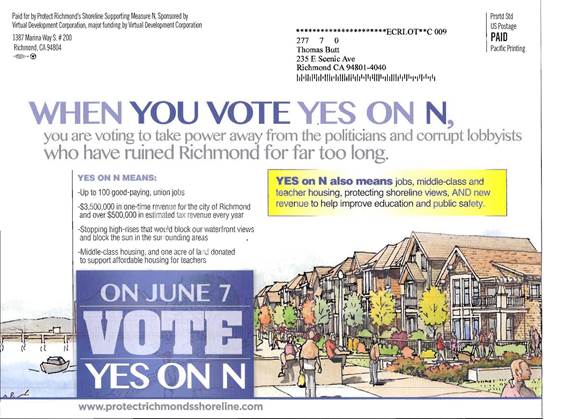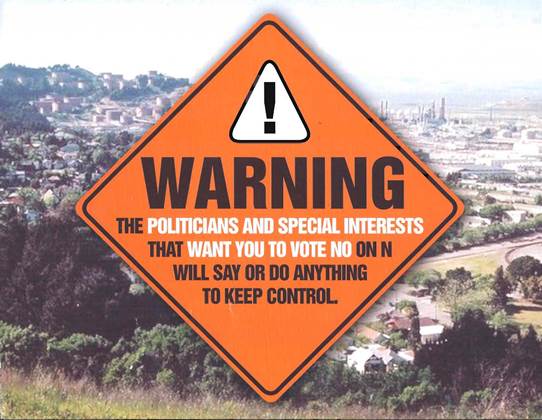Measure N
If you received the mailer shown below or perhaps several similar versions, you may be wondering what the heck this is about. Here is the story.
Richard Poe, a Florida resident, whose family was involved in developing Marina Bay, owns the vacant parcel between Lucretia Edwards Park and the Craneway/Rosie the Riveter WWII Home Front National Historical Park Visitor Center.
For reasons that make no sense to anyone but Poe, he wanted to build “The Richmond Riviera,” a low density housing project on the property, which is inconsistent with the Richmond General Plan 2030 that designates the site for higher density, mixed-use development. The parcel was designated for higher densities and mixed use because:
· It is adjacent to the Richmond Ferry Terminal scheduled to open in 2018. The more people who live proximate to the ferry terminal, the better chance the ferry has of being a success. Developing Poe’s property at a higher density is what is known as transit oriented development, in this case served by both bus and ferry as well as the Bay Trail, a smart growth strategy that public policy supports for its sustainability.
· The site is next to the Craneway and Rosie Visitor Center, both high intensity uses that attract a lot of public visitation locally, regionally and nationally.
· Development on the site will block no views. The nearest existing residential development is nearly one-half mile to the north.
When Poe’s preliminary proposal was poorly received by the Richmond Planning Department, as well as several City Council and Planning Commission members he had approached, he withdrew his application before it even reached the Design Review Board and Planning Commission. Instead, he paid for an initiative campaign to put it on the ballot and submit it to the voters. It is now on the June 7 ballot as Measure N.
Measure O
In an act of collateral spite towards City staff who did not embrace his project and the City of Richmond, he also paid to qualify a companion Measure O, that arbitrarily limits the compensation of the city manager to five times the median household income of Richmond. You may know that out of 101 cities in the nine-county Bay Area, Richmond has the lowest median household income, except for San Pablo. If passed, this measure would restrict city manager compensation to an amount insufficient to offer a competitive contract.
Oppose Measure N and O
You should know that I oppose Measure N, as do many Richmond leaders. We don’t agree on everything, but the Richmond Progressive Alliance and I both believe that Measure N is bad policy for the City of Richmond. If approved, Measure N would lock the City into a one-sided development agreement that totally favors Poe and bypass any public hearings or approvals for his project, including CEQA, the Design Review Board and the Planning Commission.
Poe claims that the public prefers low density housing, but his project is so low density,11.99 dwelling units per acre (DUA), that it would be less than any other project already built in Marina Bay. Poe asserts that the alternative to his project is a massive high rise, but the alternative doesn’t have to be that. For example, Anchor Cove is 22.9 DUA and The Anchorage 18.21 DUA. The proposed Laconia development at Terminal 1 near Brickyard Cove is 28.06 DUA. The point is that Poe’s proposal is so low density, it is an anomaly and makes no sense for its location.
Poe also claims his project will “protect shoreline views,” but any alternative project on that property will have to protect shoreline views and provide public access, as required by the Bay Conservation and Development Commission (BCDC).
TRAC, the Trails for Richmond Action Committee, opposes Measure N because it crowds the Bay Trail. As shown by the image below, the Richmond Riviera project is crammed up against the Bay Trail between Lucretia Edwards Park and the Visitor Center for the Rosie the Riveter/WWII Home Front National Historical Park. In contrast, the Toll Brothers' residential housing project previously approved for this site was set back 100’ from the shoreline, as was the Shea/Bottoms project approved by the City last year at Brickyard Cove. Moreover, all houses in previous Marina Bay developments were built with substantial setbacks from the shoreline as approved by the City in the late 1980s.

In his mailers, Poe calls his project “middle class housing,” but such a low-density project on prime waterfront land would be the most expensive housing in Marina Bay, and perhaps among the most expensive in Richmond. He also claims that he will “donate a site to support affordable housing for teachers,” an empty promise that is not a part of the Richmond Riviera project or any other project under consideration in Richmond.
Elections Code Section 9212
Elections Code Section 9212 provides that the Richmond City Council, as the designated legislative body for the City of Richmond, may refer the proposed initiative to any city agency or agencies for a report on any of the following: (1) fiscal impacts; (2) effects on the internal consistency of the city’s general and specific plans, including the Housing Element, the consistency between planning and zoning; (3) effects on the use of land, the impact on the availability and location of housing, and the ability of the city to meet its regional housing needs; (4) impacts on funding for infrastructure of all types, including, but not limited to, transportation, schools, parks, and open space; (5) impacts on infrastructure costs or savings, including the costs of infrastructure maintenance, to current residents and businesses; (6) impacts on the community’s ability to attract and retain business and employment; (7) impacts on the uses of vacant parcels of land; (8) impacts on agricultural lands, open space, traffic congestion, existing business districts, and developed areas designated for revitalization; and (9) any other matters the City Council requests to be in the report.
Click here for the full Section 9212 Reports for Measure N and Measure O.
For Measure N, the 9212 Report states, “Perhaps most significantly, the Initiative would remove the City’s right to conduct any environmental review under the California Environmental Quality Act (CEQA), which in turn prohibits the City from determining and disclosing all potential environmental impacts and effects, even though the Project may pose environmental risks that affect the use of land and property nearby.”
For Measure O, the 9212 Report states, “Thee Initiative, if adopted, would limit the amount of total compensation that can be paid to a City Manager to an amount well below market rates. This would significantly hamper the City’s ability to attract and retain qualified candidates to serve as City Manager.”
Poe’s Mailers


For additional information about Measures N and O, see the links below:
Initiative: Riveria Project (Measure N)
Full Initiative
Ballot Title and Summary
Primary Arguments
Argument in Favor of Measure N
Argument Against Measure N
Rebuttals
Rebuttal to Argument in Favor of Measure N
Rebuttal to Argument Against Measure N
Initiative: Compensation (Measure O)
Full Initiative
Ballot Title and Summary
Primary Arguments
Argument in Favor of Measure O
Argument Against Measure O
Rebuttals
Rebuttal to Argument in Favor of Measure O
Rebuttal to Argument Against Measure O
Arguments/Rebuttals Policy - Resolution 11-16 |

